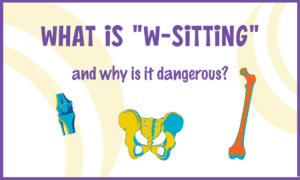We’ve all seen students in our classes who sit in this position – seat on the floor with hips internally rotated, thighs touching or almost touching and feet outwards. If you were to look at the child from a bird’s eye view, their legs make the shape of a W. Sometimes, in little children, it even looks cute. But, what is W-sitting really doing to our students and how can we help?

What causes W-sitting?
W-sitting is a com mon position for infants and toddlers who have:
• Weak core muscles
• Anatomical differences in their hip structure
• Simply find it to be a comfortable position
This position provides a strong base of support and allows kids to play without the concern of falling over. It’s normal for kids to move in and out of W-sitting while playing on the floor. However, sitting in this position for extended periods of time can cause long-term problems.
W-sitting is mostly seen from ages 2 and up. It can start to cause problems in children from the age of 3 when the bones and joints are less malleable.
Anatomically speaking…
If we look internally at the structures of the hips, pelvis and knees, we can see the stress it puts on these joints by rotating them to their extremes. Additionally, W-sitting emphasizes incorrect trunk posture and weakness begins to develop.

Long-term problems from W-sitting
• Weak core and postural muscle development can have an effect on handwriting, back pain and breathing difficulties
• Tight and shortened hip muscles can cause problems with gait when walking
• Twisting in the hip and knee joints can cause early onset of arthritis
• Weakness and injury in the hip and knee joints from over-lengthening or shortening of ligaments
• Limited trunk rotation can cause reduced ability to cross the midline, which can lead to coordination and motor planning problems.
• Increased risk of hip dysplasia (hip dislocation)

So – what can we do to encourage a safe seated position?
• Encourage different positions when sitting for long periods of time
• Cross-legged
• Long sitting (legs extended)
• Side sitting
• Kneeling
• Alternate sitting positions. This helps students not rely on one position. Some students may need to be helped up, so offering your hands to grab onto as you gently lift them to their knees can help them to get out of a W-sit safely.
• Utilize verbal cues (e.g. Criss Cross, Apple Sauce! or simply asking the student to change to a different sitting position)
• Choose activities that require alternating floor positions to encourage core development in multiple facets, equal placement of posture, diverse muscle development and greater progress in their gross motor skills.
• Bear crawls
• Wheelbarrow walks
• Yoga poses
Encouragement from teachers can help students break this automatic habit and choose safer positions and movements.
As always, ask the dancer, their family and their therapist how to best support the individual.
Rhythm Works Integrative Dance is committed to helping to meet the needs of all students. While we focus on working with students who have special needs, we have no doubt it helps all students.
Written by Karly Pierce Lystadin in collaboration with Rebecca Shanhun, RWID Certified Instructor and Advisory Board Member
https://rhythmworksid.com/
